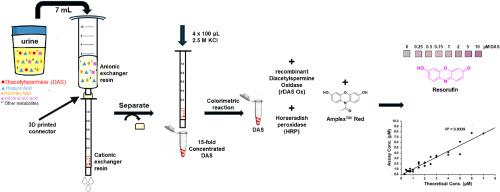A novel colorimetric assay for the detection of urinary N1, N12-diacetylspermine, a known biomarker for colorectal cancer
IF 2.5
4区 生物学
Q2 BIOCHEMICAL RESEARCH METHODS
引用次数: 0
Abstract
Urinary N1, N12-diacetylspermine (DAS) is a known biomarker for colorectal cancer (CRC). However, DAS levels in both healthy and CRC patients’ urine samples are extremely low and often challenging to quantify. Complex and expensive methods do exist to detect DAS in urine, but simpler, less expensive methods to detect DAS are needed, especially in low resource settings. Here we describe a highly efficient, fast, precise, and inexpensive colorimetric assay to detect low levels of DAS in human urine samples. We used recombinant diacetylspermine oxidase (rDAS Ox), expressed and extracted from E. coli, to oxidize DAS, producing three products including hydrogen peroxide (H2O2). The level of DAS present, which correlates with H2O2 levels, was measured using horseradish peroxidase (HRP), which together with H2O2, oxidized Amplex™ Red to produce the pink-colored resorufin. The concentration of resorufin is directly proportional to H2O2 (and DAS) levels. As urine contains metabolites which interfere with these oxidation reactions, we developed a simple two column-based protocol using ion exchange resins to remove these compounds and concentrate the DAS. With this novel cleaning and concentrating method, DAS was concentrated 15 times (confirmed by nuclear magnetic resonance (NMR) spectroscopy) and <1 μM DAS could be detected. Correlation graphs of urine samples spiked with known DAS concentrations versus assay-determined DAS concentrations had high coefficients of determination (R2) for 0–10 μM DAS (0.94) and for 0–1 μM DAS (0.91), clearly demonstrating the excellent performance of the two-column protocol with the rDAS Ox reaction mixture. To the best of our knowledge, this is first reported colorimetric enzymatic assay that quantitates DAS in urine.

用于检测尿液中 N1、N12-二乙酰精胺(一种已知的结直肠癌生物标记物)的新型比色测定法。
尿液中的 N1、N12-二乙酰精胺(DAS)是已知的结直肠癌(CRC)生物标志物。然而,健康尿样和 CRC 患者尿样中的 DAS 含量都极低,而且通常难以量化。检测尿液中 DAS 的方法复杂且昂贵,但我们需要更简单、更便宜的方法来检测 DAS,尤其是在资源匮乏的环境中。在此,我们介绍了一种高效、快速、精确且廉价的比色法,用于检测人体尿样中低水平的 DAS。我们使用从大肠杆菌中表达和提取的重组双乙酰精胺氧化酶(rDAS Ox)来氧化 DAS,产生包括过氧化氢(H2O2)在内的三种产物。辣根过氧化物酶(HRP)与 H2O2 一起氧化 Amplex™ Red,生成粉红色的 resorufin,DAS 的含量与 H2O2 的含量相关。雷索卢芬的浓度与 H2O2(和 DAS)水平成正比。由于尿液中含有干扰这些氧化反应的代谢物,我们开发了一种简单的双柱方案,使用离子交换树脂去除这些化合物并浓缩 DAS。通过这种新颖的清洁和浓缩方法,DAS 浓缩了 15 倍(经核磁共振 (NMR) 光谱证实),2) 0-10 μM DAS 的浓缩率为 0.94,0-1 μM DAS 的浓缩率为 0.91,这清楚地表明了双柱方案与 rDAS Ox 反应混合物的卓越性能。据我们所知,这是首次报道定量检测尿液中 DAS 的比色酶法。
本文章由计算机程序翻译,如有差异,请以英文原文为准。
求助全文
约1分钟内获得全文
求助全文
来源期刊

Analytical biochemistry
生物-分析化学
CiteScore
5.70
自引率
0.00%
发文量
283
审稿时长
44 days
期刊介绍:
The journal''s title Analytical Biochemistry: Methods in the Biological Sciences declares its broad scope: methods for the basic biological sciences that include biochemistry, molecular genetics, cell biology, proteomics, immunology, bioinformatics and wherever the frontiers of research take the field.
The emphasis is on methods from the strictly analytical to the more preparative that would include novel approaches to protein purification as well as improvements in cell and organ culture. The actual techniques are equally inclusive ranging from aptamers to zymology.
The journal has been particularly active in:
-Analytical techniques for biological molecules-
Aptamer selection and utilization-
Biosensors-
Chromatography-
Cloning, sequencing and mutagenesis-
Electrochemical methods-
Electrophoresis-
Enzyme characterization methods-
Immunological approaches-
Mass spectrometry of proteins and nucleic acids-
Metabolomics-
Nano level techniques-
Optical spectroscopy in all its forms.
The journal is reluctant to include most drug and strictly clinical studies as there are more suitable publication platforms for these types of papers.
 求助内容:
求助内容: 应助结果提醒方式:
应助结果提醒方式:


